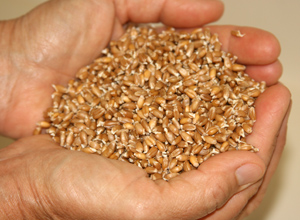Harvesting Sprouted Grain
26 August 2019It looks as if it is going to be an increasingly difficult harvest with reports already of grain beginning to sprout in the ear. Sprouted grain only has a value as an animal feed but fortunately there is very little or no difference in its nutritive value compared with whole grain.
The big problem is the higher cost of preserving it. Chitted grain will have a higher moisture content, increasing drying costs. This is likely to be further aggravated by weather forcing crops to be harvested in less than ideal conditions.
Crimped Grain
A good system would be to crimp it, ideally within 2 or 3 days of harvest and apply an acid preservative or possibly an appropriate inoculant.
The clamp should be lightly rolled e.g. by carefully using a quad bike or compressing it with the bucket of a foreloader and then immediately sheeted. It is essential to thoroughly baited against rats and to avoid storing things on top of the pit, particularly straw which provides rats with warmth, protection, etc.
One problem with crimped grain, particularly with moisture levels above 20% is it can form lumps which will have to be broken down before it can be fed.
In very wet conditions urea treatment would seem and ideal way to preserve chitted grain. However the sprouts do contain sugar which, in combination with ammonia can form imidazoles, a combination which causes bovine bonkers i.e. animals to run into walls, etc. As a consequence we would not recommend ammonia treated for grain which is fully chitted.
Basil Lowman, val.angus@sac.co.uk
Sign up to the FAS newsletter
Receive updates on news, events and publications from Scotland’s Farm Advisory Service

